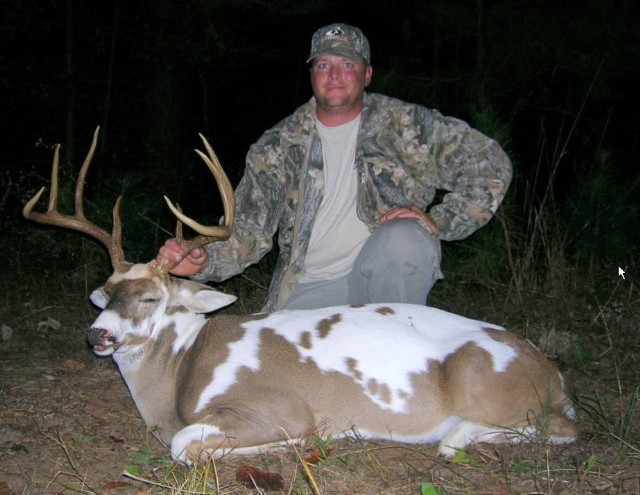Camo whitetail
MULEY7MM
11/24/08 9:11pm
I found this on a fishing web site and thought i would share it is a nice buck for sure i know hawk knows more on what causes this i tried to search for a past post he made but couldnt find it ](*,)
6,491

Muley7MM, here is what I THINK I know about Piebald deer and other pigmentation "issues" when it comes to deer. Of course, I may be wrong on a few things but most should be pretty close to true. (I wrote the Piebald stuff last. I actually went back to my posts that you were refering to and just pulled a lot of it from there....I guess I'm lazy but thought it was easier that re-typing it..LOL)
Albinism/Melanism/Leucistism
To keep it short, Albinism is a result of a hypopigmentary congenital disorder. Albinism is a result of the lack of pigment melanin.
Melanism is the opposite of Albinism and turns the subject black...or much darker than normal. Although Albinism is caused by a recessive gene and is not "contagious" (It can occur even if both parents are normal...or can occur if only one parent carries the recessive gene), Melanism can be passed through bloodlines OR can be caused by environmental changes or human "actions" such as industrial pollution. Both can also occure in various forms or stages such as abundism or psuedo-abundism which causes stripped or spotted animals to grow wider or more encompassing spots and/or stripes. Piebald is another genetic "quirk" resultant of a lack of pigmentation in spots or areas vice an all-encompassing covereage. (See additional info I dug up below)
The picture of the white Muley buck outside of Meeker, CO is an example of a leucistic animal. In other words, he suffered from a pigment cell, or chromatophore, defect. He is not suffering from a lack of melanin production and therefore is not an albino...hence the normal eyes and presence of some black areas. Again, these types of genetic "quirks" are refered to as leucistism.
One really interesting thing I found in my studies is that there are links that suggest that Melanism can/does effect the immune system of the animal in question creating a better resistance to viruses/viral infections.
Piebald
A pigmentation issue which causes spots or patterns on the animal and is passed on through recessive genes (Another form of leucistism). It's really nothing that causes any real adverse health effects although some piebald deer have been reported to have curved spines and/or shorter legs than normal. Most piebalds are as healthy as thier normal-colored counterparts though. I have also read were some biologists have made attempts to link Piebald to inbreeding but I have not found any papers/books/research findings that have proven without a doubt that inbreeding is a cause.
My thoughts....if the buck and doe, whether related or not, are carriers of this recessive gene, then a resulting Piebald birth may occur. It may not totally be a function of inbreeding, rather it may be that that particular deer "family" carries that gene and continue to pass it along since "new blood" is not being introduced into that particular family line. Again, JUST my thoughts...I am NOT a biologist! But, wouldn't that also explain why some Piebald deer have curved spines, shorter legs, etc? I think that the defects are directly related to the inbreeding while the Piebald is just a function of one gene being carried through that particular bloodline.
Just an interesting fact: Pie" means "mixed up;" "bald" means "having a white spot." Hence a Piebald deer. They are also sometimes refered to as "pinto deer".
I hope this helps. If I am wrong on any of this, PLEASE let me know! I love to read and study this sort of stuff and I would also love to hear if what I have learned is incorrect.
The first is the buck I refered to that was outside of Meeker CO. It was suffering from Leucistism.
The second buck is a "black" Whitetail. It was suffering from Melanism.
The third buck is a true albino.